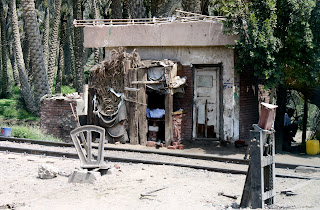Modern Luxor grew out of the ruins of Thebes, once the capital of ancient Egypt’s New Kingdom (1550-1069 BC). The monumental temples at Luxor and Karnak were famed throughout the ancient world and have attracted tourists since Greek and Roman times, most notably, Alexander the Great!
The largest of the two temples is Karnak, which encompasses 62 acres of land. We spent an hour and forty-five minutes walking through Karnak, and we didn’t walk and see the full 62 acres - too hot! At the heart of the immense Karnak complex lies the Temple of Amun, dedicated to the king of the gods. With its endless courts, halls, colossi and huge sacred lake, the scale and complexity of this sprawling temple is overwhelming. From it’s modest 11th-Dynasty beginnings, pharaoh after pharaoh added to and changed the existing buildings, seeking to make their mark on Egypt’s most important temple. No expense was spared and during the 19th Dynasty, some 80,000 men worked in the temple as laborers, guards, priests and servants. The temple lay buried under sand for more than 1,000 years before excavation work began in the mid-19th century.
A row of ram headed sphinx led to the Nile River.
Tomb of Seti II
Priests purified themselves in the holy water of the Sacred Lake before performing rituals in the temple.
The Sound and Light Show at Karnak
Karnak with a full moon above it.
Directly down the block from Karnak is Luxor Temple. They used to be connected by the Avenue of Sphinx. The government is currently excavating the streets from Karnak to Luxor Temple, to unearth the rest of the Sphinx to recreate the Avenue of the Sphinx. Luxor Temple is dedicated to the Theban triad of Amun, Mut and Khonsu. The temple was largely completed by the 18th-Dynasty pharaoh Amenhotep III, and was added to during the reign of Ramses II in the 19th-Dynasty. Although the temple was further modified by later rulers, including Alexander the Great, its design remained strikingly coherent in contrast to the sprawling complex at Karnak.
The Avenue of Sphinx that will connect to Karnak one day.
Luxor Temple
Over the centuries it was engulfed in sand and silt, and a village grew up within the temple walls. Then in 1881, archeologist, Gaston Maspero, rediscovered the temple in remarkably good condition, but before excavation work could begin the village had to be removed. Only the Abu al-Haggag Mosque, built by the Arabs in the 13th century, was left intact, standing high on the layers of silt accumulated over the years. It is also believed that the mosque was built on top of a Christian church given the Romans once occupied the area as well.
Abu al-Haggag Mosque in Luxor Temple
In front of the entrance to the temple is a gigantic pylon that is completely decorated with scenes of Ramses II's victory over the Hittites in the battle of Qadesh.
The Pylon at Luxor Temple
Two enormous seated colossi of Ramses II and a huge obelisk flank the gateway to the temple. The obelisk was originally one of pair, but the other was removed and given to France, as a gift from Mohammed Ali, for their help in discovering the temple. The obelisk currently stands in the Place de la Concorde in Paris. I have seen that one too!
The obelisk and the Colossi of Ramses II.
More giant black granite statues of Ramses II guard the entrance to the original part of the temple with its avenue of 14 columns. The walls here were embellished during the reign of Tutankhamun and depict the annual Opet festival, when the images of Amun, Mut and Khonsu were taken in procession from Karnak to Luxor.
The colonnade leads to the superb Court of Amenhotep III, which is noted for its double rows of towering papyrus columns.
The hypostyle hall on the southern side of the court serve as a vestibule to the main temple. The antechamber beyond was converted into a church by Romans in the 4th century AD, its Pharaonic reliefs being plastered over and covered with Christian paintings.
The conversion of the temple to a Christian chapel.
The Christian plaster paintings that covered the Egyptian carvings.
A second, smaller antechamber, the offerings chapel, leads on to another columned hall with the Sanctuary of the Sacred Barque in the center. Rebuilt by Alexander the Great this granite shrine was where Amun's barque ended its journey from Karnak in the Opet festival.
This "little" temple has so much history in it. I can go on and on with stories of Ramses II and everyone else that has walked through this temple. I will say it is so amazing, even if it is second to Karnak.
Sunset at Luxor Temple





















































